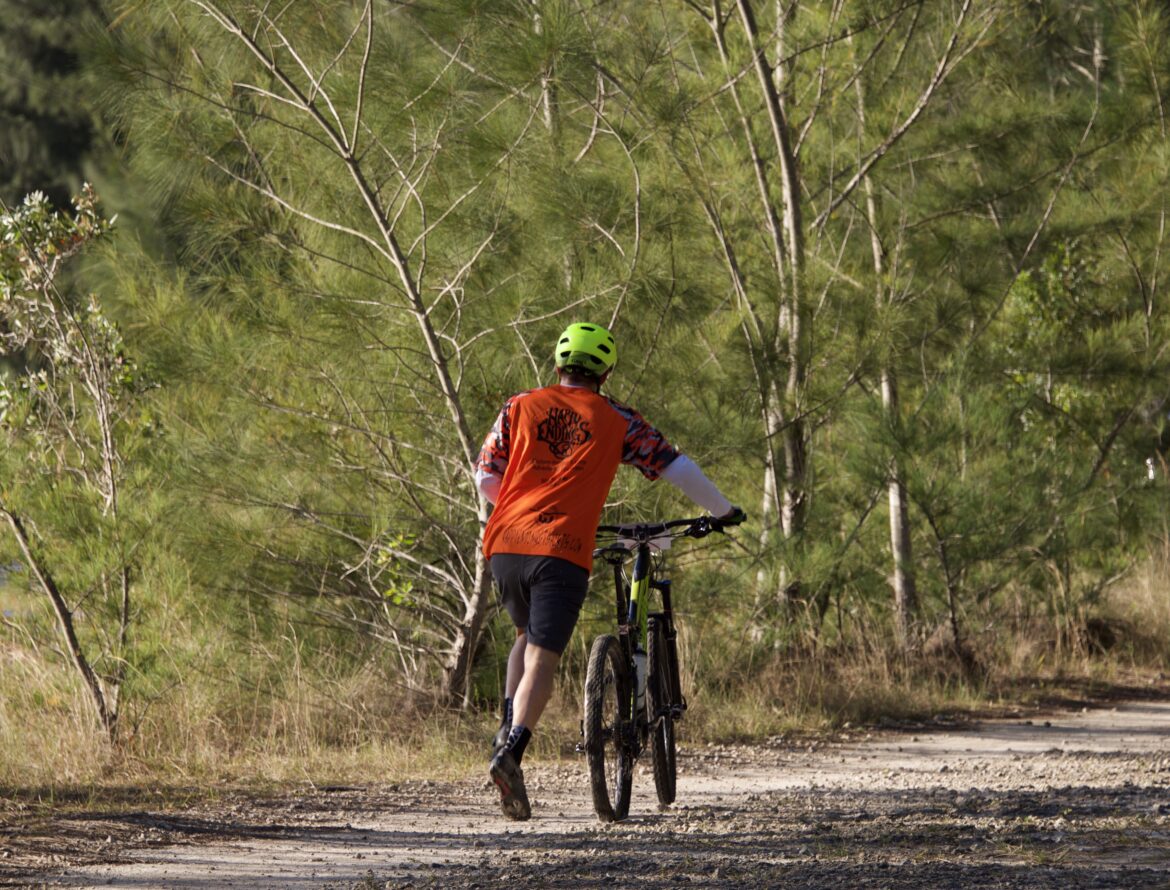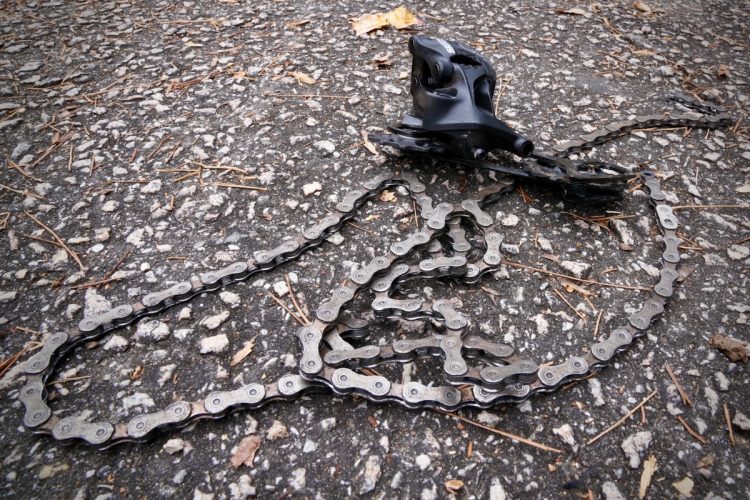
I enjoy a good, healthy hike in the woods. The fresh air, exercise, peace, and natural beauty of the surroundings make pretty much any day spent on the trail a great one. Even better is enjoying those woods, fresh air, and natural beauty while zipping around on two knobby tires. Virtually any day spent attacking challenges on two-wheels, flirting with some danger, and rolling along non-paved trail is enough to send your spirits soaring. Despite my affinity for both of these joyous outdoor activities, I make every effort to keep my mountain bike rides and hiking trips separate from one another. I enjoy both activities a great deal, just not… together.
Unfortunately, I have been forced on numerous occasions to take my bike on a walk in the woods. Unlike my dog, my bike finds no joy in being walked. The feeling is entirely mutual; my dog walks herself, while my suddenly non-functioning bike is reduced to something akin to hauling an exceptionally well-fed toddler through the woods, without the swaddling Kanga-carrier. I don’t find that to be a pleasant or enjoyable activity. Nor have I ever seen “hiking a bike” listed on the outdoor activities lists of any leading outdoor retailer’s website, leading me to believe it is not a desirable pursuit. Nonetheless, spend enough time on mountain bikes and sooner or later you will discover the failures of some mysterious mechanical engineer who did not anticipate you. Enter the unplanned, unwanted, mixing of two entirely pleasant outdoor activities into one totally crappy, “hike-a-broken-bike” event.
There is no question that a sudden mechanical failure can turn a wondrous day in the woods into the land-based equivalent of a nautical disaster. The rider-psyche is entirely unprepared when a bike ride suddenly becomes an unplanned hiking trip. Three, four, seven, maybe twenty miles into a bike ride, staring at some broken part that has reduced your $3,000 shred-machine into 30 pounds of “cargo,” you have some real moments of clarity. “I didn’t pack for this,” I tell myself, “I’m not even dressed for a hike.” Indeed, MTB huck-wear is less than ideal for a long walk in the woods, and spandex? Hope you brought the talcum or corn starch.
Now, I am not laying all of the blame for unplanned bike-hiking on the mysterious, afore-mentioned engineer. Being the cheap-skates that me and my riding buddies are, I’m not altogether sure some of the parts we have purchased ever had an engineer involved as part of the design process. I’m also not certain that the factories which manufacture some of these aforementioned parts have reached the point on the industrial evolution continuum that is “quality control.” We actually have one bike in our group we refer to as the Ebay-er. Thankfully, this bike was retired before any serious problems could occur. But the Ebay-er drew its majestic title (with some real affection I might add) from the “full carbon parts group,” it received from an E-Bay seller in Southeast Asia. I am not sure which brand the parts claimed to be manufactured by, if any. The brand name was printed in a very enticing, swirling font made to look like something sold by a mainstream company. The Ebay-er never really got the opportunity to create a hike-a-bike experience, as it was retired before important things could start breaking off of it. Yet, we were at least prepared for the Ebay-er to break at any time or place.
The Ebay-er was an outlier in this riding group of mine: it was new and fresh from the factory across the Pacific. For our initial years on bikes, we much preferred the “make me an offer” used bikes available within 100 to 200 miles of our homes. We approached used bikes for a time like the doctors who re-assembled the six-million-dollar man. “We can rebuild it….we can make it better….”
I don’t remember the government doctors who re-assembled Steve Austin ever uttering the phrase, “I found a great deal.” But why should that matter? These used bikes were, much like the afore-mentioned Mr. Austin, made mostly from metal. Metal is metal, no? I wasn’t fond of high school chemistry, and I recall not failing that class by the slimmest margin possible (it was a miracle), but I only remember there being one steel, one aluminum, and one titanium. With that in mind, wasn’t a steel flat pedal, a steel flat pedal? Standing deep in the woods holding a pedal in my hand that had sheared off at the crankarm, I suddenly had my doubts. This was going to be a long hike. Damn… steel.

Even in instances where an actual, qualified engineer was involved, they likely did not design their products with me in mind. As the mechanic at the local bike shop used to say to me (following numerous unplanned visits), “Look at you. You’re 6’4, 230 pounds. You declare war on this bike every time you ride it.” He was way off-base though. I was only 225 pounds.
I have a faint recollection from yet another science class I barely survived, that metals age. Perhaps this should have been something we considered before purchasing several used Gary Fisher brand bikes. We were big fans. Our first full-suspension bikes! A family member once raced on Fishers. That he had raced them while in college, and was now long since designated “alumni” never really crossed my mind. That an extra-large frame might have been ridden by someone similarly extra-large was also not something I considered. Metal is strong! I acknowledge now that we engaged in nothing short of “elder abuse.” I’m sorry, Gary Fisher. Numerous riders within my group tortured the fine creations of the former engineers employed by his namesake bike company.
In my defense, the pair of Gary Fisher Sugars we bought were a great deal, it’s just that the “deal” was likely the result of their date of manufacture. The poor bikes had lived, as far as I could tell, an apparently blissful existence since their creation in a Taiwanese welding shop in 2002 and 2003. They had maintained the majority of their original parts in working order, and even picked up a half-dozen wicked cool frame stickers and after-market add-ons from countless seasons of happy riding. The 2002 model never stood a chance. After some of my longer unplanned hikes with that Fisher, bike mechanics have actually asked: “how the hell did you do that,” about whatever particular part I managed to mangle that time. I’m not really prepared to answer those questions yet, so I will simply say, I am not a “finesse-y rider.”
The 2003 Fisher, on the other hand, almost made it. The 2003 had been retired and replaced and only met its maker as a “lender.” There is hiking a bike, and there is hiking a bike on your first ride ever. The former sucks, but the latter is catastrophic toward continued riding by said first-timer. My riding group actually uses the experience of the latter as a term-of-art: we refer to it as the “full Bobby.”

The “full Bobby” experience is best defined as: putting a first timer on a lender and leading them on trails they likely should not have ridden yet, aboard a bike that is mechanically equivalent to a hand grenade with the pin missing. Things started going wrong early in that fateful ride, but in our typical fashion, we ignored those readily apparent warning signs and continued the outbound journey. “Bobby” seemed a tad large for the 2003 Fisher, but it is not as though we could observe that, since he was always ensconced at the rear of the group.
When the Fisher-ocolypse occurred we were deep in the woods and Bobby was thrown from the bike. Covered in mud and superficially bleeding, he attempted to walk his way out to the car. With no tell-tale straightforward path to follow, and forgetting our exceptionally detailed directional instructions, he became lost, and wandered the woods and dirt roads until he came upon a pair of teenagers on working bikes. The teens eyed the mud- and blood-covered stranger warily. Bobby was oozing desperation. He begged them to lead him out, coming as close as anyone I have ever known to holding another person hostage. Sensing his empty-water-bottle-level of desperation, they agreed to guide him back to the entrance. The once proud 2003 Fisher was finished. The frame had cracked at the bottom bracket, and the shock could no longer hold air. The drivetrain had seized, with the old chain twisted at a 90-degree angle in a pair of links. It would never be ridden again. Nor has Bobby ever straddled a mountain bike since. Some bike hikes are more consequential than others.
As a group we have sought penance for our mistakes of the past by ensuring we never give anyone “the full Bobby” again. We also invested in actual brand name parts, and new bikes, serviced at actual bike shops or by friends with actual knowledge of bicycle maintenance. This has led to fewer unplanned bike-hikes, but that does not mean I am not prepared. The “trauma” of these extended hikes with a useless 30-pound pile of broken bike has had consequences on my psyche. I broke along with the bike. I admit it: I now wear a fanny pack.
I don’t wear some dainty, easy to conceal fanny pack. My fanny pack is not some bike-specific hydration model either. I went all-in with 550 cubic inches of sewn cordura nylon cargo volume strapped to my lower lumbar spine. My friends treat me like a red-nosed reindeer and ruthlessly make jokes at my, and the lumbar pack’s expense. Yet, hypocrisy not being dead, they ask me to carry their keys for them, and sometimes they need the spare water bottle I stash in the main cargo compartment, or a granola bar forgotten at the bottom of the voluminous pack.
I sense that my friends’ greatest enjoyment comes when I need something from deep within the pack. As I dig, my various abnormal emergency parts are revealed. Unlike the world’s better-known rescue packs, I do not carry a small cask of whiskey (though, I’d be willing to test the usefulness of such rescue gear on the mountain bike world). My gear includes: One purple pedal (the unbroken one from a set that once powered my daughter’s bike) and a pedal wrench. One spare chain, master links and a chain break tool. The chain is short, because it’s a left over from an old broken chain that I had to cut links from, but it got me back to the car from seven miles deep in the South Carolina woods. Several wraps of toilet paper, because, you just never know, and it is hard to find suitable leaves in the winter. A derailleur hanger. A multi-tool. I also carry virtually every size hex wrench known to man, better to be safe than sorry as manufacturers can’t seem to agree on standards. I tote a shock pump, and various tubes in all sizes. This penchant for hauling various tubes led to what I can only refer to as “my moment of heroism” on a bike trip last summer.
Nobody was laughing when 10-miles deep on a rental bike on the Upper Peninsula of Michigan, a fellow rider blew a flat. He was riding “light,” because “it’s more comfortable,” without a pack. As my companion fretted about the endless walk back to the shop (down the hill, on to the street, and through the city), I quietly unbuckled the fanny pack and strode to the wounded bike. Without saying a word, I turned the bike over and removed the crippled wheel. Pushing my purple pedal, shock pump, multi-tool, spare water bottle, car keys, chain and chain break, questionably-aged granola bar, emergency rain glasses, TP, energy gels, and 27.5” tube aside, I removed a pump, pair of tire levers, and a 29” tube from the depths of the pack. Like some mixture of a Sherpa hauling gear up K2, and a NASCAR pit crew changing a tire, I set to my hero’s work. Within minutes, I had saved the day. Wordlessly, I repacked my gear and re-shouldered the fanny-pack. Thanks? Entirely unnecessary. The knowing look in my companion’s eyes offered more thanks than words ever could: his silent acknowledgement that my 550 cubic inch fanny pack had saved him.
There would be no bike-hiking that day.




















6 Comments
Sep 10, 2020
Sep 10, 2020
Sep 9, 2020
Sep 10, 2020
Sep 4, 2022
May 25, 2022